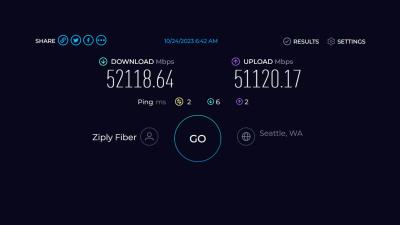Google Fiber just made headlines with plans to launch a new 20 Gbps internet service that offers more than twice the speed of its current top tier offering. Ziply Fiber’s new residential plan, though, completely steals the show. CEO Harold Zeitz told Fierce it is now offering a 50-gig service – that’s 5x the speed of its current 10-gig offering – across its entire footprint…and it isn’t using PON to do it.
“It’s not PON, it’s Ethernet,” Zeitz said. “We’ve architected our network differently than others so we can either deliver a PON network to the home or we can deliver a direct fiber connection, in which case we could deliver any speed. We could deliver 400 [gigs] if we wanted to.”
While Ziply does use XGS-PON for its 2-gig and 5-gig service offerings, Zeitz noted it’s actually also using Ethernet to deliver its 10-gig service. That’s because Zeitz said he’s a stickler for providing more than the full speeds advertised and even XGS-PON can’t quite deliver a full 10 Gbps service due to overhead constraints.
To be clear, the new plan isn’t a 50-gig service that is mostly aimed at businesses and also available to consumers as a bonus. Zeitz said it has been offering 50G, 100G, 400G and wavelength services to enterprises for some time now, and this new plan is aimed directly at residential customers.
But why?

The fact that Ziply is using Ethernet for its new service makes sense given 50G-PON isn’t really in play yet. Sure, the International Telecommunication Union published the first 50G-PON standard in late 2021, but much of the buzz in the fiber world today remains squarely focused on XGS-PON and, occasionally, 25G-PON (as in Google Fiber’s case). That’s in part because there are few Wi-Fi routers yet that support 50G-PON (Ziply recommends the Mikrotik CCR2216-1G-12XS-2XQ) and only a handful of end-user devices that do. The latter, of course, require a direct connection to do so.
Zeitz acknowledged this, noting that “for all practical purposes, you’re not going to get 50-gig on Wi-Fi.” Instead, he said that bandwidth can be spread across devices, with some going to Wi-Fi and the rest elsewhere.
Asked why Ziply decided to roll out a 50-gig offer given these circumstances, Zeitz said “We can’t define what the bandwidth needs of a community will be in next five or 10 years… We think bringing that future capability now will lead to lots of innovation.” Or put another way: if you build it, they will come.
But just how many might come remains an open question. Zeitz admitted it likely won’t be a large number. For context, around two-thirds of Ziply’s customers take plans with speeds of a gig or more. A quarter of those are on multi-gig plans. Fierce asked Zeitz about Ziply’s subscriber numbers, but he declined to respond, citing its status as a private company.
Still, that means that even though the 50-gig plan is priced at $900 per month (which, for the record is significantly cheaper than EPB’s $1,500 per month 25G consumer service) it likely won’t have a very significant impact on ARPU, he said.
Expansion update
Formed in 2020 via the acquisition of assets from Frontier Communications, Ziply has been steadily working to upgrade its footprint from copper to fiber. Last year, Ziply raised $450 million to accelerate its progress and tackle new edge out markets outside its footprint.
To date, Ziply has launched in four edge out markets – Yakima, Walla Walla, Union Gap and Grandview, Washington – and has another six or so under construction.
By the end of 2023, Zeitz said 60% of Ziply’s locations will be fiberized.
